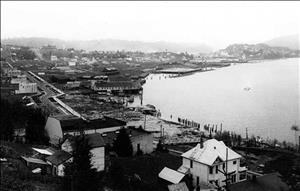On September 27, 1890, South Bend, future county seat of Pacific County, incorporates. Settled in the 1860s, the town has grown to include sawmills, stores, churches, and social organizations. The Northern Pacific Railway selected the town for a terminus in 1889 and this spurred a building boom. The South Bend Land Company guided this development through the sale of its land near the mouth of the Willapa River and by donating a large tract to the railroad and lots to churches. In 1892 residents will lead a successful campaign to make South Bend the new county seat. Though South Bend's boom will go bust during the Panic of 1893, the town survives the ensuing recession and builds its economy on lumber, oyster farming, and the county government.
Early Days
In 1869 brothers Valentine (1817-1876) and John (b. ca. 1830) Riddell built a mill at the mouth of the WIllapa River, in Pacific County. Among the sloughs of the narrow river valley a number of farmers had claimed land. They lived alongside the Willapa Chinook (also known as Shoalwater Chinook) and the Lower Chehalis Indians who lived along Willapa Bay, Grays Harbor, and the Chehalis River.
Some of the farmers also did some logging or operate logging camps, using the river to float the logs to sawmills. Over the next two decades, the town grew to include several sawmills, stores, an Odd Fellows Hall, and a Masonic Lodge.
Developing a Town
In 1889, a group of area residents pooled their capital and formed the South Bend Land Company. Captain A. T. Stream, a bar pilot on Shoalwater Bay; George U. Holcomb and Lewis N. Eklund, real estate promoters; Captain P. W. Swett; and Charles H. Warner bought almost 2,000 acres from area landowners. Some of these landowners sold their entire stake to the land company; others retained a portion for their own house or retained a group of lots to develop themselves.
That same year, representatives from the Northern Pacific Railway came to town and began looking for land on which to locate a terminus. A land boom ensued, with $70,000 worth of property transferred on one day, April 1, 1890. On April 18, the land company secured the railroad by donating a substantial tract of land on riverfront on the east end of town to the railroad in exchange for assurances that the town would become a terminus for a rail line connecting South Bend with the main Northern Pacific line that ran between Tacoma and Portland.
Incorporation
On September 9, 1890, voters approved a measure to incorporate the town of South Bend. George U. Holcomb, of the South Bend Land Company, became the first mayor. Fred G. Reed, Scott Riddell, John M. Etiner, Everett Burnham (b. ca. 1844), and George Bloomhart (b. ca. 1866) served as the first council, and W. E. Cromwell served as treasurer.
A June 1890 article in the Spokane Falls Review identified South Bend as the "center of population and trade" on Willapa Bay ("On Willapa Bay"). It noted that the town had two hotels, "several good restaurants," three saloons, a public school, a Sunday school, a bank, three stores, two sawmills, the South Bend Enterprise newspaper, and 14 real estate offices.
Surviving and Thriving
A bust would soon follow the boom, partly due to inflated prices and partly because of the recession following the Panic of 1893. Railroad service, which began in August 1893, partially mitigated the effects of the bust, as did the transfer of the county seat to South Bend in February 1893.
South Bend saw exponential growth after 1900, reaching a population of 3,023 by 1910, as the economy recovered and the timber industry grew. Since the 1910s, the town has maintained a population of just under 2,000, with an economy built on county government and oyster farming and processing.

